sensor BMW 540I 2002 E39 Central Body Electronics ZKE Manual
[x] Cancel search | Manufacturer: BMW, Model Year: 2002, Model line: 540I, Model: BMW 540I 2002 E39Pages: 80, PDF Size: 4.14 MB
Page 38 of 80
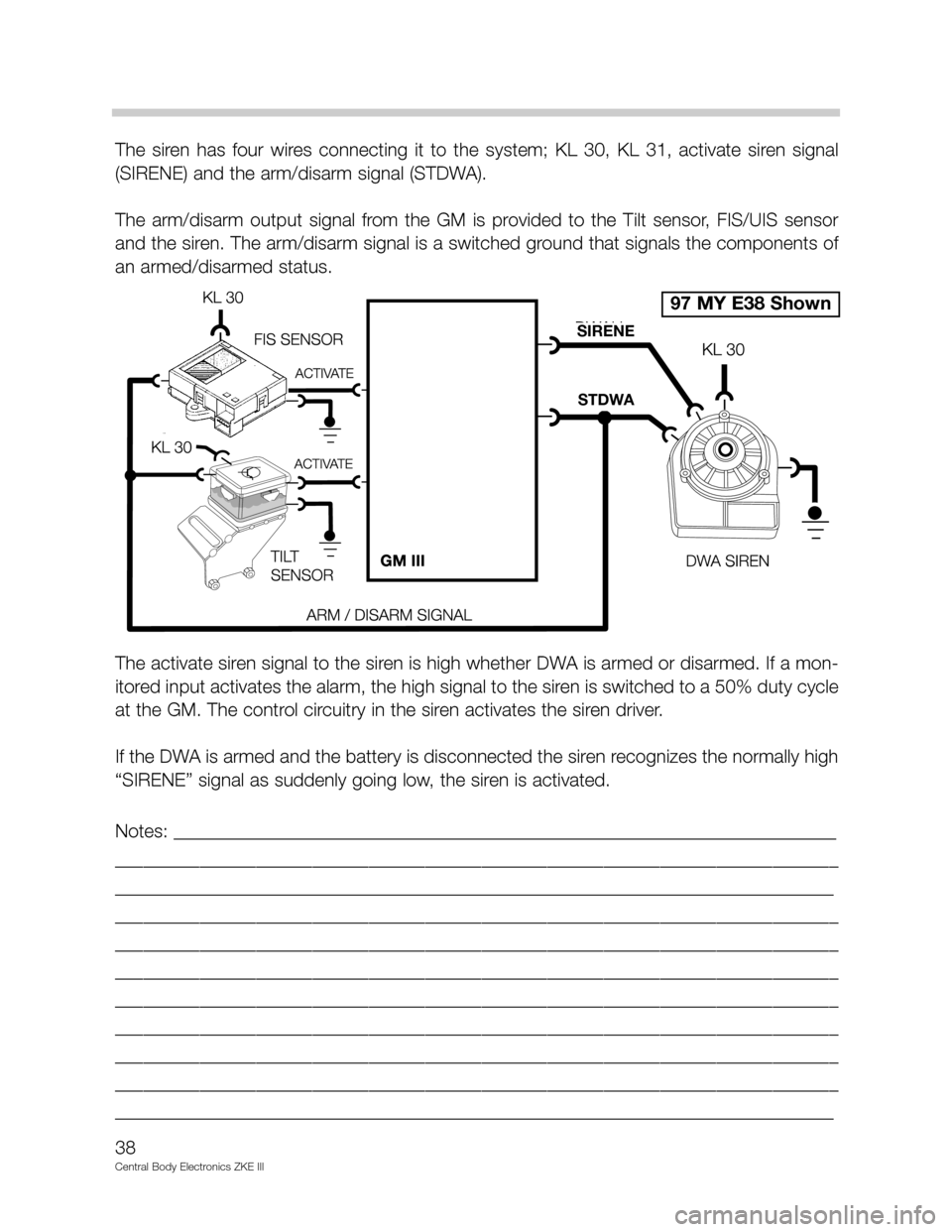
The siren has four wires connecting it to the system; KL 30, KL 31, activate siren signal
(SIRENE) and the arm/disarm signal (STDWA).
The arm/disarm output signal from the GM is provided to the Tilt sensor, FIS/UIS sensor
and the siren. The arm/disarm signal is a switched ground that signals the components of
an armed/disarmed status.
The activate siren signal to the siren is high whether DWA is armed or disarmed. If a mon-
itored input activates the alarm, the high signal to the siren is switched to a 50% duty cycle
at the GM. The control circuitry in the siren activates the siren driver.
If the DWA is armed and the battery is disconnected the siren recognizes the normally high
“SIRENE” signal as suddenly going low, the siren is activated.
Notes: _______________________________________________________________________
_____________________________________________________________________________
_____________________________________________________________________________
_____________________________________________________________________________
_____________________________________________________________________________
_____________________________________________________________________________
_____________________________________________________________________________
_____________________________________________________________________________
_____________________________________________________________________________
_____________________________________________________________________________
_____________________________________________________________________________
38
Central Body Electronics ZKE III
SIRENE
STDWA
97 MY E38 Shown
Page 40 of 80

Principle of Operation
DWA Arming/Disarming
• The DWA is armed every time the vehicle is locked from the outside with the door lock
cylinder or FZV key.
• The DWA LED flashes as an acknowledgment along with the exterior lights and a
momentary chirp from the siren.
• The GM monitors all required input signals for closed status (door closed, luggage com-
partment closed, etc.) The inputs must be in a closed status for a minimum of 3 sec-
onds for the GM to include them as an activation component. If after 3 seconds any
input signal not in the closed status is excluded (this is acknowledged by the DWA LED)
preventing false alarm activations. The hood switch can be “lifted” to the service posi-
tion to test the alarm with the hood open.
• If the DWA is armed a second time within 10 seconds, the tilt sensor and interior pro-
tection sensor are excluded as alarm activation components. This function is useful if
the vehicle is transported on a train or flat bed truck to prevent false alarm activations.
• While armed, the trunk can be opened with out the alarm being triggered as follows:
- If opened with the trunk remote button via the FZV, the GM prevents the alarm from
activating. (This feature is customizable under the Car Memory function).
- If opened with the key at the trunk lock cylinder the trunk key position switch sig-
nals the GM and in the same manner prevents the alarm from activating.
In either case, when the trunk is returned to the closed position, it is no longer con-
sidered as an activation signal.
Panic Mode Operation: When the trunk button is pressed and held, the GM is signaled
to activate the siren for the Panic Mode. The panic mode is function with either an armed
or disarmed DWA system.
Emergency Disarming: Emergency disarming occurs automatically if a key is used to turn
the ignition switch on and the EWS accepts it. The EWS signals the GM to unlock the doors
and deactivate the DWA.
40
Central Body Electronics ZKE III
Page 47 of 80
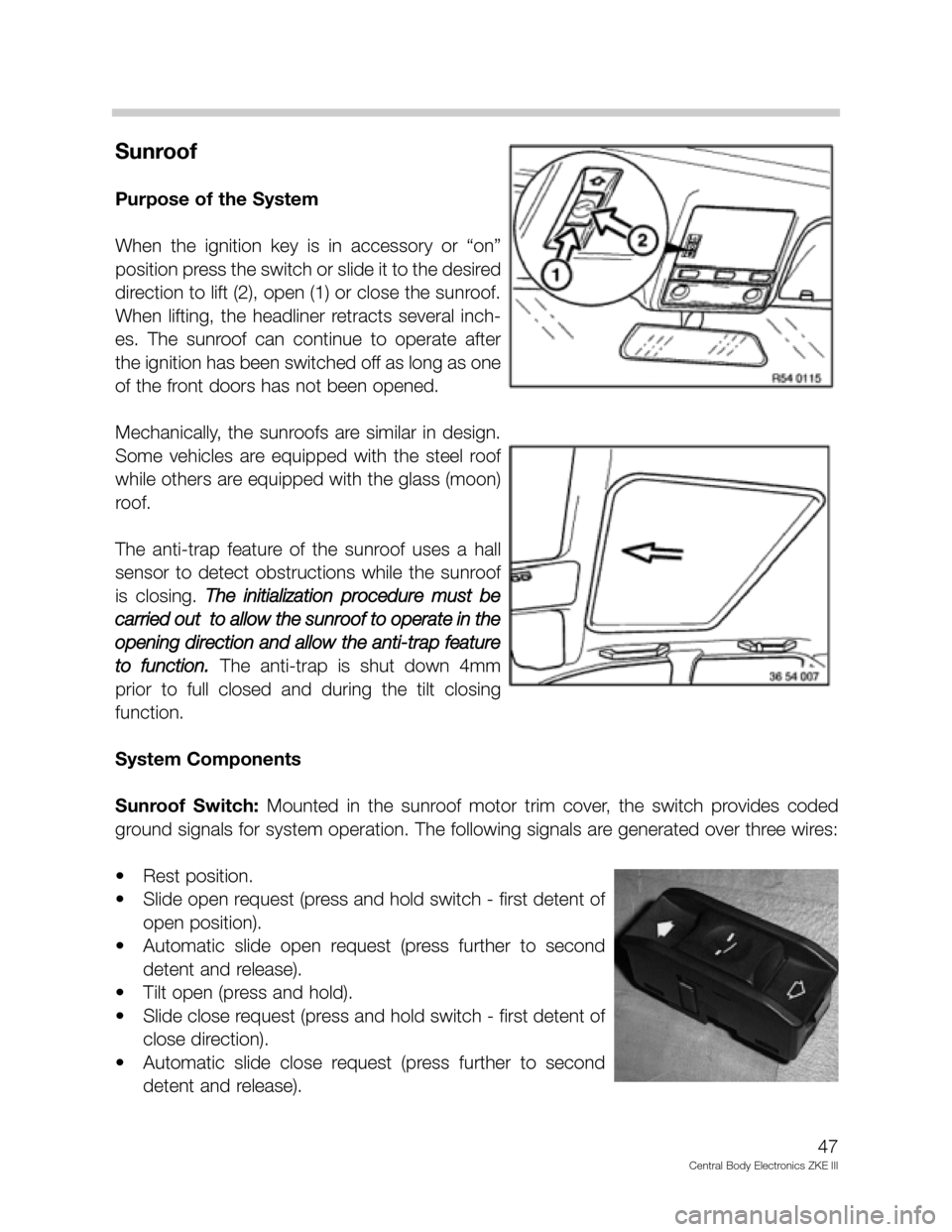
Sunroof
Purpose of the System
When the ignition key is in accessory or “on”
position press the switch or slide it to the desired
direction to lift (2), open (1) or close the sunroof.
When lifting, the headliner retracts several inch-
es. The sunroof can continue to operate after
the ignition has been switched off as long as one
of the front doors has not been opened.
Mechanically, the sunroofs are similar in design.
Some vehicles are equipped with the steel roof
while others are equipped with the glass (moon)
roof.
The anti-trap feature of the sunroof uses a hall
sensor to detect obstructions while the sunroof
is closing. The initialization procedure must be
carried out to allow the sunroof to operate in the
opening direction and allow the anti-trap feature
to function.
The anti-trap is shut down 4mm
prior to full closed and during the tilt closing
function.
System Components
Sunroof Switch:Mounted in the sunroof motor trim cover, the switch provides coded
ground signals for system operation. The following signals are generated over three wires:
• Rest position.
• Slide open request (press and hold switch - first detent of
open position).
• Automatic slide open request (press further to second
detent and release).
• Tilt open (press and hold).
• Slide close request (press and hold switch - first detent of
close direction).
• Automatic slide close request (press further to second
detent and release).
47
Central Body Electronics ZKE III
Page 48 of 80
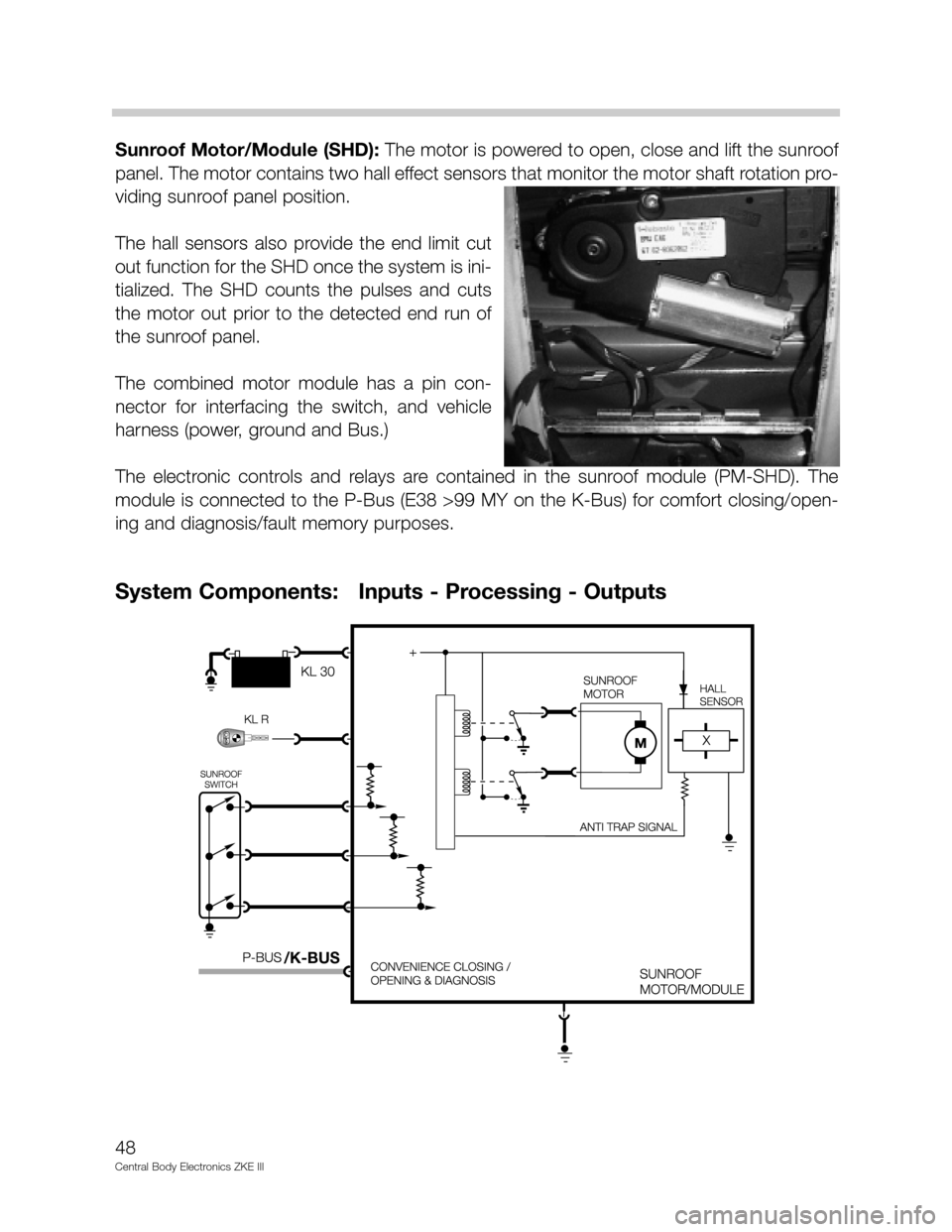
Sunroof Motor/Module (SHD): The motor is powered to open, close and lift the sunroof
panel. The motor contains two hall effect sensors that monitor the motor shaft rotation pro-
viding sunroof panel position.
The hall sensors also provide the end limit cut
out function for the SHD once the system is ini-
tialized. The SHD counts the pulses and cuts
the motor out prior to the detected end run of
the sunroof panel.
The combined motor module has a pin con-
nector for interfacing the switch, and vehicle
harness (power, ground and Bus.)
The electronic controls and relays are contained in the sunroof module (PM-SHD). The
module is connected to the P-Bus (E38 >99 MY on the K-Bus) for comfort closing/open-
ing and diagnosis/fault memory purposes.
48
Central Body Electronics ZKE III
System Components: Inputs - Processing - Outputs
/K-BUS
Page 49 of 80

Principle of Operation
Initialization: Initialization is required for the SHD to learn the end positions of the motor's
travel. The hall sensors provide pulses for motor rotation, the SHD counts the pulses and
determines where the panel is by memorizing the stored pulses.
If the system is not initialized, the sunroof will only operate in the tilt up and slide close posi-
tions. Initialize as follows:
• Press and hold the sunroof switch in either the tilt up or slide close positions for 15 sec-
onds.
• The sunroof motor operates momentarily signifying initialization acceptance.
The SHD memorizes the pulses from the hall sensors on the next activation of the motor
by driving the panel to its end run positions. The SHD senses an amperage increase and
determines the end run position. The counted number of pulses is then used as the basis
for calculating the panel position.
Anti-Trap Feature: The anti-trap feature of the sunroof uses a hall sensor to detect
obstructions while the sunroof is closing (pulse frequency slowed down) in the automatic
close function. The anti-trap feature is shut down prior to full closing (4mm from full closed)
to allow the sunroof to seat into the seal.
Note: The anti-trap feature is not functional when the switch is held in the manual close
position.
Notes: _______________________________________________________________________
_____________________________________________________________________________
_____________________________________________________________________________
_____________________________________________________________________________
_____________________________________________________________________________
_____________________________________________________________________________
_____________________________________________________________________________
_____________________________________________________________________________
_____________________________________________________________________________
_____________________________________________________________________________
_____________________________________________________________________________
_____________________________________________________________________________
49
Central Body Electronics ZKE III
Page 50 of 80
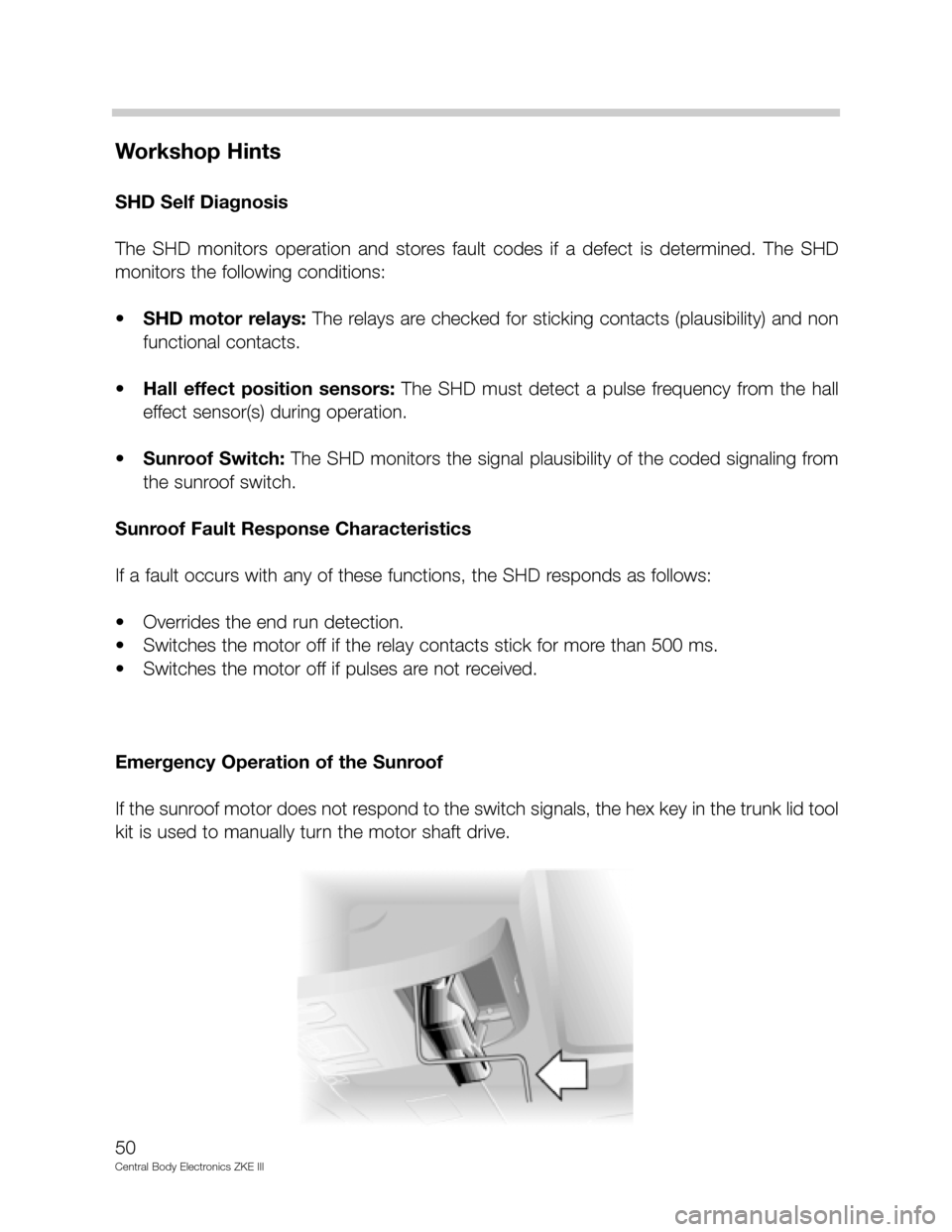
Workshop Hints
SHD Self Diagnosis
The SHD monitors operation and stores fault codes if a defect is determined. The SHD
monitors the following conditions:
• SHD motor relays:The relays are checked for sticking contacts (plausibility) and non
functional contacts.
• Hall effect position sensors:The SHD must detect a pulse frequency from the hall
effect sensor(s) during operation.
• Sunroof Switch: The SHD monitors the signal plausibility of the coded signaling from
the sunroof switch.
Sunroof Fault Response Characteristics
If a fault occurs with any of these functions, the SHD responds as follows:
• Overrides the end run detection.
• Switches the motor off if the relay contacts stick for more than 500 ms.
• Switches the motor off if pulses are not received.
Emergency Operation of the Sunroof
If the sunroof motor does not respond to the switch signals, the hex key in the trunk lid tool
kit is used to manually turn the motor shaft drive.
50
Central Body Electronics ZKE III
Page 53 of 80
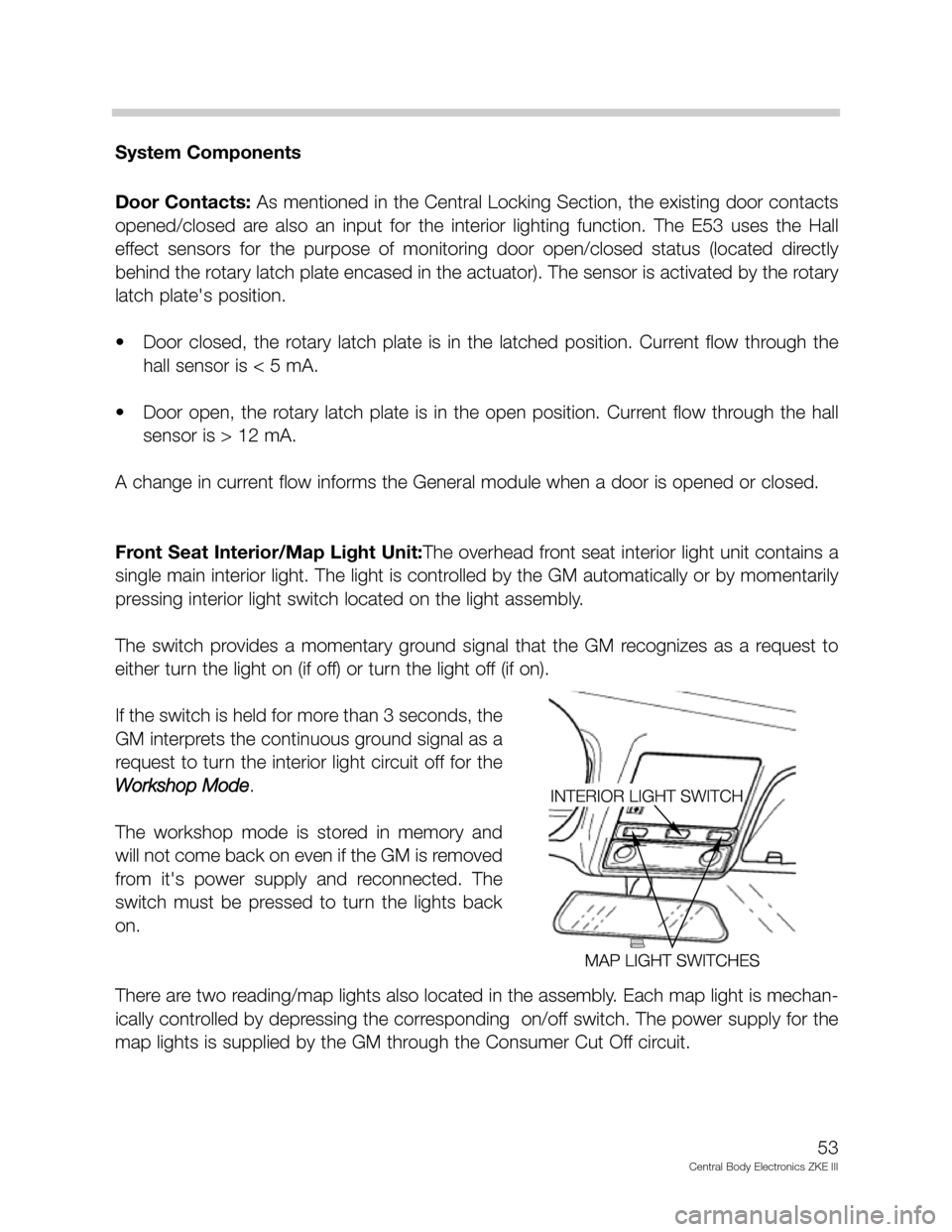
System Components
Door Contacts: As mentioned in the Central Locking Section, the existing door contacts
opened/closed are also an input for the interior lighting function. The E53 uses the Hall
effect sensors for the purpose of monitoring door open/closed status (located directly
behind the rotary latch plate encased in the actuator). The sensor is activated by the rotary
latch plate's position.
• Door closed, the rotary latch plate is in the latched position. Current flow through the
hall sensor is < 5 mA.
• Door open, the rotary latch plate is in the open position. Current flow through the hall
sensor is > 12 mA.
A change in current flow informs the General module when a door is opened or closed.
Front Seat Interior/Map Light Unit:The overhead front seat interior light unit contains a
single main interior light. The light is controlled by the GM automatically or by momentarily
pressing interior light switch located on the light assembly.
The switch provides a momentary ground signal that the GM recognizes as a request to
either turn the light on (if off) or turn the light off (if on).
If the switch is held for more than 3 seconds, the
GM interprets the continuous ground signal as a
request to turn the interior light circuit off for the
Workshop Mode
.
The workshop mode is stored in memory and
will not come back on even if the GM is removed
from it's power supply and reconnected. The
switch must be pressed to turn the lights back
on.
There are two reading/map lights also located in the assembly. Each map light is mechan-
ically controlled by depressing the corresponding on/off switch. The power supply for the
map lights is supplied by the GM through the Consumer Cut Off circuit.
53
Central Body Electronics ZKE III
Page 66 of 80
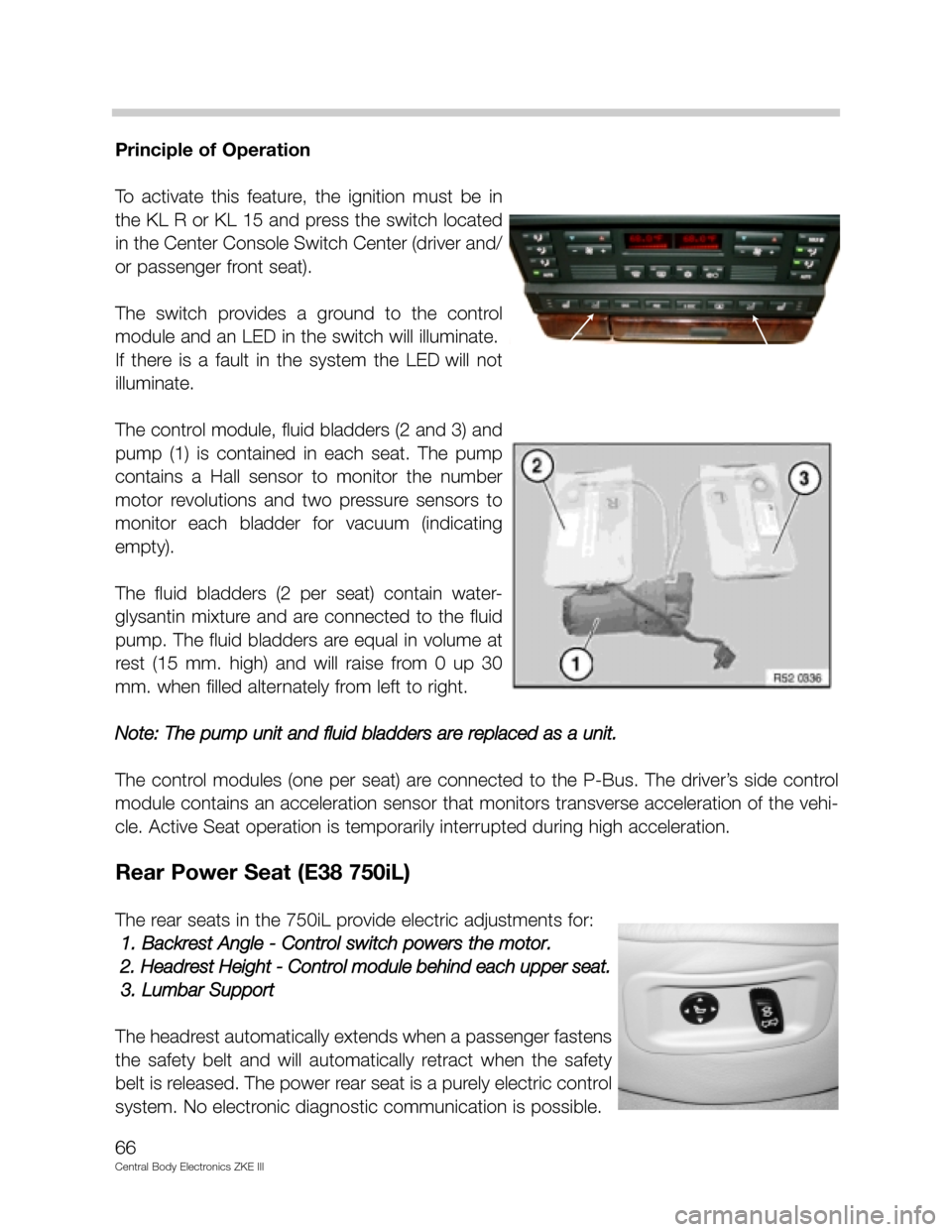
Principle of Operation
To activate this feature, the ignition must be in
the KL R or KL 15 and press the switch located
in the Center Console Switch Center (driver and/
or passenger front seat).
The switch provides a ground to the control
module and an LED in the switch will illuminate.
If there is a fault in the system the LED will not
illuminate.
The control module, fluid bladders (2 and 3) and
pump (1) is contained in each seat. The pump
contains a Hall sensor to monitor the number
motor revolutions and two pressure sensors to
monitor each bladder for vacuum (indicating
empty).
The fluid bladders (2 per seat) contain water-
glysantin mixture and are connected to the fluid
pump. The fluid bladders are equal in volume at
rest (15 mm. high) and will raise from 0 up 30
mm. when filled alternately from left to right.
Note: The pump unit and fluid bladders are replaced as a unit.
The control modules (one per seat) are connected to the P-Bus. The driver’s side control
module contains an acceleration sensor that monitors transverse acceleration of the vehi-
cle. Active Seat operation is temporarily interrupted during high acceleration.
Rear Power Seat (E38 750iL)
The rear seats in the 750iL provide electric adjustments for:
1. Backrest Angle - Control switch powers the motor.
2. Headrest Height - Control module behind each upper seat.
3. Lumbar Support
The headrest automatically extends when a passenger fastens
the safety belt and will automatically retract when the safety
belt is released. The power rear seat is a purely electric control
system. No electronic diagnostic communication is possible.
66
Central Body Electronics ZKE III
Page 67 of 80

67
Central Body Electronics ZKE III
Seat Heating Operation (from 99 MY)
Principle of Operation
The front seat heaters are adjustable through three ranges of
heating output temperature.
Pressing the respective seat heater button once provides
stage 1:
• All three LEDs illuminate and the heating elements are provided regulated output current
producing a seat temperature of 111
OF.
Pressing the button a second time provides stage 2:
• The top LED switches off and the heating elements are regulated to an output tempera-
ture of 102
OF.
Pressing the button a third time provides stage 3.
• The top and middle LEDs are off and the heating elements are regulated to an output tem-
perature of 95
OF.
The SZM monitors the seat heating element temperature via an NTC feedback signal to
regulate the output current which maintains the seat temperature.
Seat heating is switched off by pressing the button a fourth time,
pressing and holding the
button for more than 1 second or when the ignition is switched off.
System Components
Carbon Fiber Heating Pads:In each seat is a two
section heating pad wired in parallel. The heating pads
are resistors which when powered produce radiant
heat.
The seat base heating element also contains a temper-
ature sensor for feedback to provide the temperature
regulation output control.
KL31
KL15
TEMPERATURE
SENSOR
615200139.eps
Page 68 of 80

68
Central Body Electronics ZKE III
Center Console Switch Center (SZM): From 1999 MY E38, E39 and E53 vehicles are
equipped with a SZM to control the front seat heating and provide a diagnostic interface
with the DISplus/MoDiC via the K BUS.
The SZM directly controls:
• Front Seat Heating
• Rear Window Roller Blind
SZM also provides a unitized switching center
for:
• Park Distance Control (PDC)
• Dynamic Stability Control (DSC III)
• Electronic Damper Control (EDC).
The switch signal output for these systems is a direct output signal. All diagnosis functions
are carried out through their respective control systems.
SZM Monitoring of Seat Heating
Battery Voltage:The SZM switches current supply to the heating elements off when bat-
tery voltage drops below 11.4 volts. However, the heating stage LEDs remain on.
Regulated output current resumes when battery voltage raises above 12.2 volts for more
than 5 seconds.
SZM Internal Temperature: The power output stages for the seat heating elements gen-
erate a considerable amount of heat when in stage 1 operation. The SZM monitors it’s own
internal temperatures and reduces the heating output when internal temperatures rise to a
temperature of 185
OF or switches it off completely above 203OF. As with battery voltage
monitoring, the heating stage LEDs remain on when these temperatures are exceeded.
Fault Monitoring:The SZM monitors the temperature sensors and heating mats for faults.
Detected faults are stored in the SZM. Fault Symptom Troubleshooting in conjunction with
stored faults will initiate the diagnostic paths using the DISplus/MoDiC. The following faults
can be recognized:
• Shorts or opens in the wiring circuits.
• Shorts or opens in the temperature sensors.
• Open in heating element.
If a short is detected in the temperature sensor, the seat heating is switched off to prevent
overheating. The Stage LEDs are also switched off with this fault present.